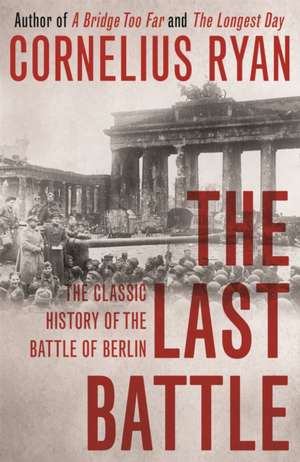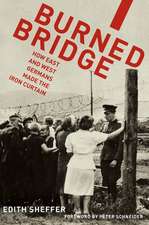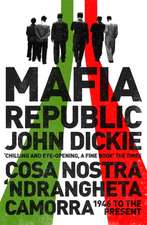The Last Battle
Autor Cornelius Ryanen Limba Engleză Paperback – 17 iun 2015
| Toate formatele și edițiile | Preț | Express |
|---|---|---|
| Paperback (2) | 54.79 lei 3-5 săpt. | +29.23 lei 7-13 zile |
| Hodder & Stoughton – 17 iun 2015 | 54.79 lei 3-5 săpt. | +29.23 lei 7-13 zile |
| Simon&Schuster – 30 apr 1995 | 135.12 lei 3-5 săpt. |
Preț: 54.79 lei
Preț vechi: 70.76 lei
-23% Nou
Puncte Express: 82
Preț estimativ în valută:
10.49€ • 10.91$ • 8.79£
10.49€ • 10.91$ • 8.79£
Carte disponibilă
Livrare economică 20 februarie-06 martie
Livrare express 06-12 februarie pentru 39.22 lei
Preluare comenzi: 021 569.72.76
Specificații
ISBN-13: 9781473620070
ISBN-10: 1473620074
Pagini: 480
Dimensiuni: 130 x 198 x 31 mm
Greutate: 0.32 kg
Editura: Hodder & Stoughton
ISBN-10: 1473620074
Pagini: 480
Dimensiuni: 130 x 198 x 31 mm
Greutate: 0.32 kg
Editura: Hodder & Stoughton
Notă biografică
Cornelius Ryan was born in 1920 in Dublin. He covered World War II from the frontline, attached to General Patton's army until the end of the war in 1945. He emigrated to the USA in 1947 and became one of the most important and respected war journalists of his generation, writing critically acclaimed articles and books until his death in 1976.
Extras
Chapter 1
In the northern latitudes the dawn comes early. Even as the bombers were turning away from the city, the first rays of light were coming up in the east. In the stillness of the morning, great pillars of black smoke towered over the districts of Pankow, Weissensee and Lichtenberg. On the low clouds it was difficult to separate the soft glow of daylight from the reflections of the fires that blazed in bomb-battered Berlin.
As the smoke drifted slowly across the ruins, Germany's most bombed city stood out in stark, macabre splendor. It was blackened by soot, pockmarked by thousands of craters and laced by the twisted girders of ruined buildings. Whole blocks of apartment houses were gone, and in the very heart of the capital entire neighborhoods had vanished. In these wastelands what had once been broad roads and streets were now pitted trails that snaked through mountains of rubble. Everywhere, covering acre after acre, gutted, windowless, roofless buildings gaped up at the sky.
In the aftermath of the raid, a fine residue of soot and ash rained down, powdering the wreckage, and in the great canyons of smashed brick and tortured steel nothing moved but the eddying dust. It swirled along the broad expanse of the Unter den Linden, the famous trees bare now, the leaf buds seared on the branches. Few of the banks, libraries and elegant shops lining the renowned boulevard were undamaged. But at the western end of the avenue, Berlin's most famous landmark, the eight-story-high Brandenburg Gate, though gashed and chipped, still straddled the via triumphalis on its twelve massive Doric columns.
On the nearby Wilhelmstrasse, lined by government buildings and former palaces, shards of glass from thousands of windows glittered in the debris. At No. 73, the beautiful little palace that had been the official residence of German presidents in the days before the Third Reich had been gutted by a raging fire. Once it had been described as a miniature Versailles; now sea nymphs from the ornate fountain in the forecourt lay shattered against the colonnaded front entrance, and along the roof line, chipped and gouged by flying fragments, the twin statues of Rhine maidens leaned headless over the littered courtyard.
A block away, No. 77 was scarred but intact. Piles of rubble lay all around the three-story, L-shaped building. Its yellowish-brown exterior was scabrous, and the garish golden eagles above each entrance, garlanded swastikas in their claws, were pitted and deeply scored. Jutting out above was the imposing balcony from which the world had been harangued with many a frenzied speech. The Reichskanzlei, Chancellery of Adolf Hitler, still remained.
At the top of the battered Kurfürstendamm, Berlin's Fifth Avenue, bulked the deformed skeleton of the once fashionable Kaiser-Wilhelm Memorial Church. The hands on the charred clock face were stopped at exactly 7:30; they had been that way since 1943 when bombs wiped out one thousand acres of the city on a single November evening.
One hundred yards away was the jungle of wreckage that had been the internationally famed Berlin Zoo. The aquarium was completely destroyed. The reptile, hippopotamus, kangaroo, tiger and elephant houses, along with scores of other buildings, were severely damaged. The surrounding Tiergarten, the renowned 630-acre park, was a no man's land of room-sized craters, rubble-filled lakes and partly demolished embassy buildings. Once the park had been a natural forest of luxuriant trees. Now most of them were burned and ugly stumps.
In the northeast corner of the Tiergarten stood Berlin's most spectacular ruin, destroyed not by Allied bombs but by German politics. The huge Reichstag, seat of parliament, had been deliberately set ablaze by the Nazis in 1933 -- and the fire had been blamed on the Communists, thus providing Hitler with an excuse to seize full dictatorial power. On the crumbling portico above its six-columned entrance, overlooking the sea of wreckage that almost engulfed the building, were the chiseled, blackened words, "Dem Deutschen Volke" -- To the German People.
A complex of statuary had once stood before the Reichstag. All had been destroyed except one piece -- a 200-foot-high, dark red granite-and-bronze column on a massive colonnaded base. After the 1933 burning Hitler had ordered it moved. Now it stood a mile away on the Charlottenburger Chaussée, close to the center of the East-West Axis -- the series of linked highways running across the city roughly from the river Havel on the west to the end of the Unter den Linden on the east. As the sun rose on this March morning its rays caught the golden figure at the top of the column: a winged statue bearing a laurel wreath in one hand, a standard adorned with the Iron Cross in the other. Rising up out of the wasteland, untouched by the bombing, was Berlin's slender, graceful memorial -- the Victory Column.
Across the tormented city sirens began wailing the All Clear. The 314th Allied raid on Berlin was over. In the first years of the war the attacks had been sporadic, but now the capital was under almost continuous bombardment -- the Americans bombed by day, the R.A.F. by night. The statistics of destruction had increased almost hourly; by now they were staggering. Explosives had laid waste more than ten square miles of built-up districts -- ten times the area destroyed in London by the Luftwaffe. Three billion cubic feet of debris lay in the streets -- enough rubble for a mountain more than a thousand feet high. Almost half of Berlin's 1,562,000 dwellings had sustained some kind of damage, and every third house was either completely destroyed or uninhabitable. Casualties were so high that a true accounting would never be possible, but at least 52,000 were dead and twice that number seriously injured -- five times the number killed and seriously injured in the bombing of London. Berlin had become a second Carthage -- and the final agony was still to come.
In this wilderness of devastation it was remarkable that people could survive at all -- but life went on with a kind of lunatic normality amid the ruins. Twelve thousand policemen were still on duty. Postmen delivered the mail; newspapers came out daily; telephone and telegraphic services continued. Garbage was collected. Some cinemas, theaters and even a part of the wrecked zoo were open. The Berlin Philharmonic was finishing its season. Department stores ran special sales. Food and bakery shops opened each morning, and laundries, dry-cleaning establishments and beauty salons did a brisk business. The underground and elevated railways functioned; the few fashionable bars and restaurants still intact drew capacity crowds. And on almost every street the strident calls of Berlin's famous flower vendors echoed as in the days of peace.
Perhaps most remarkable, more than 65 per cent of Berlin's great factories were in some kind of working condition. Almost 600,000 people had jobs -- but getting to them now was a major problem. It often took hours. Traffic was clogged, there were detours, slowdowns and breakdowns. As a consequence, Berliners had taken to rising early. Everyone wanted to get to work on time because the Americans, early risers themselves, were often at work over the city by 9 A.M.
On this bright morning in the city's sprawling twenty districts, Berliners came forth like neolithic cave dwellers. They emerged from the bowels of subways, from shelters beneath public buildings, from the cellars and basements of their shattered homes. Whatever their hopes or fears, whatever their loyalties or political beliefs, this much Berliners had in common: those who had survived another night were determined to live another day.
The same could be said for the nation itself. In this sixth year of World War II, Hitler's Germany was fighting desperately for survival. The Reich that was to last a millennium had been invaded from west and east. The Anglo-American forces were sweeping down on the great river Rhine, had breached it at Remagen, and were racing for Berlin. They were only three hundred miles to the west. On the eastern banks of the Oder a far more urgent, and infinitely more fearful, threat had materialized. There stood the Russian armies, less than fifty miles away.
It was Wednesday, March 21, 1945 -- the first day of spring. On radios all over the city this morning, Berliners heard the latest hit tune: "This Will Be a Spring Without End."
Copyright © 1966 by Cornelius Ryan
Copyright renewed © 1994 by Victoria Ryan Bida and Geoffrey J. M. Ryan
In the northern latitudes the dawn comes early. Even as the bombers were turning away from the city, the first rays of light were coming up in the east. In the stillness of the morning, great pillars of black smoke towered over the districts of Pankow, Weissensee and Lichtenberg. On the low clouds it was difficult to separate the soft glow of daylight from the reflections of the fires that blazed in bomb-battered Berlin.
As the smoke drifted slowly across the ruins, Germany's most bombed city stood out in stark, macabre splendor. It was blackened by soot, pockmarked by thousands of craters and laced by the twisted girders of ruined buildings. Whole blocks of apartment houses were gone, and in the very heart of the capital entire neighborhoods had vanished. In these wastelands what had once been broad roads and streets were now pitted trails that snaked through mountains of rubble. Everywhere, covering acre after acre, gutted, windowless, roofless buildings gaped up at the sky.
In the aftermath of the raid, a fine residue of soot and ash rained down, powdering the wreckage, and in the great canyons of smashed brick and tortured steel nothing moved but the eddying dust. It swirled along the broad expanse of the Unter den Linden, the famous trees bare now, the leaf buds seared on the branches. Few of the banks, libraries and elegant shops lining the renowned boulevard were undamaged. But at the western end of the avenue, Berlin's most famous landmark, the eight-story-high Brandenburg Gate, though gashed and chipped, still straddled the via triumphalis on its twelve massive Doric columns.
On the nearby Wilhelmstrasse, lined by government buildings and former palaces, shards of glass from thousands of windows glittered in the debris. At No. 73, the beautiful little palace that had been the official residence of German presidents in the days before the Third Reich had been gutted by a raging fire. Once it had been described as a miniature Versailles; now sea nymphs from the ornate fountain in the forecourt lay shattered against the colonnaded front entrance, and along the roof line, chipped and gouged by flying fragments, the twin statues of Rhine maidens leaned headless over the littered courtyard.
A block away, No. 77 was scarred but intact. Piles of rubble lay all around the three-story, L-shaped building. Its yellowish-brown exterior was scabrous, and the garish golden eagles above each entrance, garlanded swastikas in their claws, were pitted and deeply scored. Jutting out above was the imposing balcony from which the world had been harangued with many a frenzied speech. The Reichskanzlei, Chancellery of Adolf Hitler, still remained.
At the top of the battered Kurfürstendamm, Berlin's Fifth Avenue, bulked the deformed skeleton of the once fashionable Kaiser-Wilhelm Memorial Church. The hands on the charred clock face were stopped at exactly 7:30; they had been that way since 1943 when bombs wiped out one thousand acres of the city on a single November evening.
One hundred yards away was the jungle of wreckage that had been the internationally famed Berlin Zoo. The aquarium was completely destroyed. The reptile, hippopotamus, kangaroo, tiger and elephant houses, along with scores of other buildings, were severely damaged. The surrounding Tiergarten, the renowned 630-acre park, was a no man's land of room-sized craters, rubble-filled lakes and partly demolished embassy buildings. Once the park had been a natural forest of luxuriant trees. Now most of them were burned and ugly stumps.
In the northeast corner of the Tiergarten stood Berlin's most spectacular ruin, destroyed not by Allied bombs but by German politics. The huge Reichstag, seat of parliament, had been deliberately set ablaze by the Nazis in 1933 -- and the fire had been blamed on the Communists, thus providing Hitler with an excuse to seize full dictatorial power. On the crumbling portico above its six-columned entrance, overlooking the sea of wreckage that almost engulfed the building, were the chiseled, blackened words, "Dem Deutschen Volke" -- To the German People.
A complex of statuary had once stood before the Reichstag. All had been destroyed except one piece -- a 200-foot-high, dark red granite-and-bronze column on a massive colonnaded base. After the 1933 burning Hitler had ordered it moved. Now it stood a mile away on the Charlottenburger Chaussée, close to the center of the East-West Axis -- the series of linked highways running across the city roughly from the river Havel on the west to the end of the Unter den Linden on the east. As the sun rose on this March morning its rays caught the golden figure at the top of the column: a winged statue bearing a laurel wreath in one hand, a standard adorned with the Iron Cross in the other. Rising up out of the wasteland, untouched by the bombing, was Berlin's slender, graceful memorial -- the Victory Column.
Across the tormented city sirens began wailing the All Clear. The 314th Allied raid on Berlin was over. In the first years of the war the attacks had been sporadic, but now the capital was under almost continuous bombardment -- the Americans bombed by day, the R.A.F. by night. The statistics of destruction had increased almost hourly; by now they were staggering. Explosives had laid waste more than ten square miles of built-up districts -- ten times the area destroyed in London by the Luftwaffe. Three billion cubic feet of debris lay in the streets -- enough rubble for a mountain more than a thousand feet high. Almost half of Berlin's 1,562,000 dwellings had sustained some kind of damage, and every third house was either completely destroyed or uninhabitable. Casualties were so high that a true accounting would never be possible, but at least 52,000 were dead and twice that number seriously injured -- five times the number killed and seriously injured in the bombing of London. Berlin had become a second Carthage -- and the final agony was still to come.
In this wilderness of devastation it was remarkable that people could survive at all -- but life went on with a kind of lunatic normality amid the ruins. Twelve thousand policemen were still on duty. Postmen delivered the mail; newspapers came out daily; telephone and telegraphic services continued. Garbage was collected. Some cinemas, theaters and even a part of the wrecked zoo were open. The Berlin Philharmonic was finishing its season. Department stores ran special sales. Food and bakery shops opened each morning, and laundries, dry-cleaning establishments and beauty salons did a brisk business. The underground and elevated railways functioned; the few fashionable bars and restaurants still intact drew capacity crowds. And on almost every street the strident calls of Berlin's famous flower vendors echoed as in the days of peace.
Perhaps most remarkable, more than 65 per cent of Berlin's great factories were in some kind of working condition. Almost 600,000 people had jobs -- but getting to them now was a major problem. It often took hours. Traffic was clogged, there were detours, slowdowns and breakdowns. As a consequence, Berliners had taken to rising early. Everyone wanted to get to work on time because the Americans, early risers themselves, were often at work over the city by 9 A.M.
On this bright morning in the city's sprawling twenty districts, Berliners came forth like neolithic cave dwellers. They emerged from the bowels of subways, from shelters beneath public buildings, from the cellars and basements of their shattered homes. Whatever their hopes or fears, whatever their loyalties or political beliefs, this much Berliners had in common: those who had survived another night were determined to live another day.
The same could be said for the nation itself. In this sixth year of World War II, Hitler's Germany was fighting desperately for survival. The Reich that was to last a millennium had been invaded from west and east. The Anglo-American forces were sweeping down on the great river Rhine, had breached it at Remagen, and were racing for Berlin. They were only three hundred miles to the west. On the eastern banks of the Oder a far more urgent, and infinitely more fearful, threat had materialized. There stood the Russian armies, less than fifty miles away.
It was Wednesday, March 21, 1945 -- the first day of spring. On radios all over the city this morning, Berliners heard the latest hit tune: "This Will Be a Spring Without End."
Copyright © 1966 by Cornelius Ryan
Copyright renewed © 1994 by Victoria Ryan Bida and Geoffrey J. M. Ryan
Recenzii
"A rare accomplishment . . . will be of interest to generations to come." -- James A. Michener















